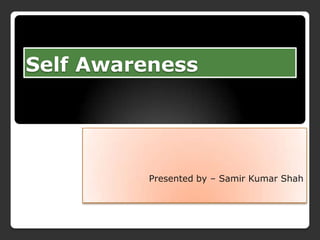
presentation on myself
- 1. Self Awareness Presented by – Samir Kumar Shah
- 2. Intro about myself NAME - SAMIR KUMAR SHAH BORN – IN FEBRUARY 1992 PLACE – ROHINI NEW DELHI QUALIFICATION – BCOM GRADUATE & PERSUING MBA FAMILY BACKGROUND - BUSINESS HOBBIES & INTREST – Swimming, wrestling, learning new things, Adventure & traveling, listening music, watching tv etc…
- 3. Self evaluation : The term self evaluation refers to the process in which an individual rates the quality of his or her own work. This normally helps him to know where he went wrong and he employs ways of improving his weakness. Self evaluation is what you do when you feel you need to make changes in your personal, emotional or professional life. You access where you are and where you want to be. The best way to answer self evaluation questions is by being honest. Don't focus on your weaknesses. Instead focus on your strengths. Explain how they are an asset.
- 4. Mbti report Humanmetrics Jung Typology Test™ Your Type ISFP Introvert(22%) Sensing(1%) Feeling(50%) Perceiving(22)% You have slight preference of Introversion over Extraversion (22%) You have marginal or no preference of Sensing over Intuition (1%) You have moderate preference of Feeling over Thinking (50%) You have slight preference of Perceiving over Judging (22%)
- 5. SWOT SWOT analysis is a strategic planning method used to evaluate the Strengths, Weaknesses, Opportunities, and Threats involved in a project, personal affaires or in a business venture. (internal factors) STRENGTHS: 2. Good in Accounting 3. Technological skills (Sturdy technical knowledge within the field of hardware, software and programming languages.) 4. Personal distinctiveness (e.g., strong work ethic, self- discipline, ability to work under pressure, creativity, optimism or high level of energy. 5. teamwork, leadership skills. WEaKNESSes 1. shyness, too emotional 2. Lack of communicational skills
- 6. (External factors) Opportunities in my Career Field : Constructive trends in my field that will create more opportunities (e.g., growth, globalization, technological advances). Opportunities for professional development in my field. Threats in my Career Field : Competition from my legion of college graduates. Obstacles in my way (e.g., lack of the communication skills).
- 7. Build up my Strengths : This is the internal positives which can control and on which i can capitalize, such as my technological skills, human relations skills, and organizational skills. I can build up my strengths through- Getting in the habit of praising other people. Refuse to engage in backstabbing gossip. During group discussion have to extrovert and speak up with confidently. Always be cool and Gratitude minded. Overcome my Weaknesses : This is the internal negatives that can control and which i can work to improve, such as my lack of communicational skills, weak public speaking skills. Moreover, I can take some initiative to overcome my weaknesses like- Be innovative and fun in my actions. Supporting my actions with my values and beliefs. . Reflection & action
- 8. MY WEAKNESSESS : 02. I am a extrovert :- i don’t get involved much into making many friends which would be a hurdle at my work place . Laziness :- i am lazy on my holidays when i am not at work. According to me these are the main weakness in me which i Can remember & i will overcome by practicing to remove it. I Will read books & will practical in my approach. Doings to grasp the Opportunities : This is the Positive external conditions that have no control but of which i can plan to take advantages. It is very much crucial to do some acts to grasp the opportunities that is waiting for me. Such as Keeping Networking events, educational classes, or conferences. Effective workshop for professional development in my relevant field. completing graduation in the relevant filed where I can grasp my upcoming opportunities.
- 9. Turn the threats into opportunities : It is very much significant to turn the threats into opportunities for my better future career. Reducing exposure to the threat. Assuring early detection. Developing contingency plans.
- 10. My expected career : Successful businessman Have a clear plan. The smartest move that I can make is to grow my family business at global level Wait for the right time. The best time consider to join my family business is when I am safely ensconced in my existing position what’s important. This is the best time for thoughtful self-reflection. Ask myself what it is I really want to do with the rest of my life. Take an honest inventory of my likes and dislikes, and evaluate my skills, values, and personal interests.
- 11. References Humphrey, Albert (December 2005). "SWOT Analysis for Management Consulting". SRI Alumni Newsletter (SRI International). "Albert Humphrey The "Father" of TAM". TAM UK. Retrieved 2012-06-03. "Object Oriented and Multi-Scale Image Analysis: Strengths, Weaknesses, Opportunities and Threats - A Review". Journal of Computer Science 4 (9): 706–712. Jan 2008. |coauthors= requires|author= (help) See for instance: Mehta, S. (2000) Marketing Strategy Menon, A. et al. (1999). "Antecedents and Consequences of Marketing Strategy Making". Journal of Marketing (American Marketing Association) 63 (2): 18–40. doi:10.2307/1251943.JSTOR 1251943. Feld, S. L. (1991). Why your friends have more friends than you do. The American Journal of Sociology. 96(6), 1464-1477. Fiske, S. T. (2004). Social beings: A core motives approach to social psychology. United States of America: Wiley. Tesser, A. (1988). Toward a self-evaluation maintenance model of social behavior. In L. Berkowitz (Ed.), Advances in experimental social psychology, Vol 21, (pp. 181–227). New York: Academic Press. Tesser, A., & Schwarz, N. (Eds.). (2001). Blackwell handbook of social psychology: Intraindividual processes. Massachusetts: Blackwell.
